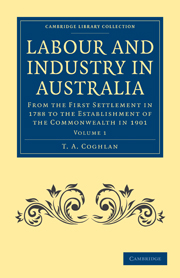 Labour and Industry in Australia
Labour and Industry in Australia Book contents
- Frontmatter
- PREFACE
- Contents
- PART I FROM THE FOUNDATION OF SETTLEMENT TO THE CROSSING OF THE MOUNTAINS
- PART II FROM THE CROSSING OF THE MOUNTAINS TO THE ABOLITION OF THE ASSIGNMENT SYSTEM
- PART III FROM THE ABOLITION OF THE ASSIGNMENT SYSTEM TO THE DISCOVERY OF GOLD
- PART IV FROM THE DISCOVERY OF GOLD TO THE INTRODUCTION OF FREE SELECTION OF LAND BEFORE SURVEY
- I INTRODUCTION TO THE FOURTH PERIOD
- II THE END OF THE CONVICT SYSTEM
II - THE END OF THE CONVICT SYSTEM
Published online by Cambridge University Press: 05 August 2011
- Frontmatter
- PREFACE
- Contents
- PART I FROM THE FOUNDATION OF SETTLEMENT TO THE CROSSING OF THE MOUNTAINS
- PART II FROM THE CROSSING OF THE MOUNTAINS TO THE ABOLITION OF THE ASSIGNMENT SYSTEM
- PART III FROM THE ABOLITION OF THE ASSIGNMENT SYSTEM TO THE DISCOVERY OF GOLD
- PART IV FROM THE DISCOVERY OF GOLD TO THE INTRODUCTION OF FREE SELECTION OF LAND BEFORE SURVEY
- I INTRODUCTION TO THE FOURTH PERIOD
- II THE END OF THE CONVICT SYSTEM
Summary
At the beginning of the period a movement was set on foot to link up the various colonies, so as to form one front to oppose the further transportation of criminals to any part of Australia. The Launceston Association took the initiative, having first secured the adhesion of leading citizens of Hobart, and two delegates (the Reverend John West and W. P. Weston) were deputed to visit Australia as representatives of the colony of Van Diemen's Land. At Melbourne a conference was held; with the local association, and expressions of goodwill having come from Adelaide and Sydney, the Australasian League and Solemn Engagement was formed, which undertook to use every effort to put an end to transportation, the individual members pledging themselves not to employ any person arriving under sentence after 1st February 1851, the date of the formation of the Association. A delegate was sent to England, and the headquarters moved to Sydney, where the movement was taken up with the greatest vehemence. In acceding to the wishes of New South Wales that there should be no more criminals transported to that country, Earl Grey indicated that there might be a slice of territory in the north cut off, for the formation of a colony willing to receive convicts for the sake of the free immigrants who would be sent with them, and whose passages would be paid for out of the grant made by the British Parliament for emigration.
- Type
- Chapter
- Information
- Labour and Industry in AustraliaFrom the First Settlement in 1788 to the Establishment of the Commonwealth in 1901, pp. 553 - 562Publisher: Cambridge University PressPrint publication year: 2011First published in: 1918


